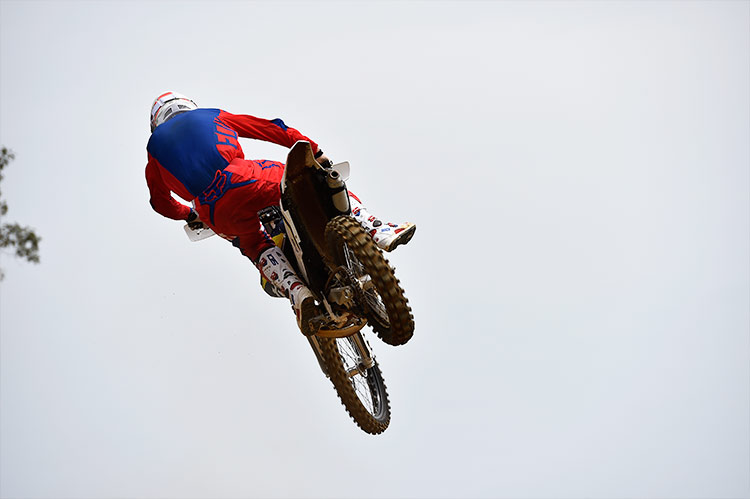The 2016 Husky TC 250 is basically the 2015 TC 250 with BNG (Bold New Graphics) though Husqvarna coined the acronym CTG (Color Trim Graphics) first. Always being different. But we’ll make an argument for this bike and its lack of changes as well as give you a look at the future of the 250cc two-stroke.
 Simply put there was not time in Austria to design another all-new bike. We’d suspect the chassis for an all-new 250cc two-stroke isn’t that much different than the one you are seeing on all the other TC and FC MX bikes, or is it? What will likely be coming in the next couple of years is an all-new motor. The configuration and fuel delivery of which should be radically new. But the attraction of the current two-stroke design is simplicity, lower cost and ease of maintenance so at this tipping point, and with little in the way of competition on a performance basis, the need isn’t time critical.
Simply put there was not time in Austria to design another all-new bike. We’d suspect the chassis for an all-new 250cc two-stroke isn’t that much different than the one you are seeing on all the other TC and FC MX bikes, or is it? What will likely be coming in the next couple of years is an all-new motor. The configuration and fuel delivery of which should be radically new. But the attraction of the current two-stroke design is simplicity, lower cost and ease of maintenance so at this tipping point, and with little in the way of competition on a performance basis, the need isn’t time critical.
Looking a bit more pretty is this 2016 TC 250. It rides on the older chassis with the older suspension components that have not been changed. But the addition of a rubber-mounted handlebar clamp does make some differences to the bike in the line that needed it the most from a vibration point of view. And the bike is really as good as it ever was.
The power is abundant and starts off very low in the RPM range even though there is little flywheel weight slowing it down. The jetting is very crisp and the delivery is just to the north side of smooth as it can be aggressive through only a little extra dose of throttle. It pulls and revs quickly but not too quick and the power revs fairly far, depending on which map switch setting you have the two-position, handlebar mounted switch set to. In the aggressive setting the TC did not feel as willing to rev on top and felt a little flat in comparison to the boosted bottom end. I preferred the standard map where the bottom end grabbed extra traction, resisted spinning and then on top it really got with the program and felt like it was giving more useable RPM, between 500-1000, before sign-off. The switch really made a difference. The good thing about riding the older chassis on the same day as all the other bikes on the new platform is it clearly shows the direction that Husky is going with chassis design. The 250 has a longer and slightly lower feel when on the bike and all the time it feels heavier. But it also feels more planted to the ground and has a higher sensation of stability—even if when doing laps it does not ride any more stable. While the steering in the turns is still very light, the bike does not fall in or turn in as effortlessly as the new chassis. Overall the suspension isn’t as supple on the bumps, especially in the rear and it does not respond to the clicker changes as sensitively. It isn’t really that far off but exemplifies how all the changes add up. The big question is how much of a difference is it?
The good thing about riding the older chassis on the same day as all the other bikes on the new platform is it clearly shows the direction that Husky is going with chassis design. The 250 has a longer and slightly lower feel when on the bike and all the time it feels heavier. But it also feels more planted to the ground and has a higher sensation of stability—even if when doing laps it does not ride any more stable. While the steering in the turns is still very light, the bike does not fall in or turn in as effortlessly as the new chassis. Overall the suspension isn’t as supple on the bumps, especially in the rear and it does not respond to the clicker changes as sensitively. It isn’t really that far off but exemplifies how all the changes add up. The big question is how much of a difference is it?
All riders will feel the weight difference and most the steering. But if you are not a rider that is critical about setting the ride height on your bike or picky about clicker changes as tracks or conditions change, the difference isn’t that much.
The TC 250 may be a little behind in chassis design compared to the latest bikes but the motor isn’t suffering just yet. From a performance point of view there are no complaints or issues holding it back. And for a lot of riders the more planted and slower handling feel is a positive. And we’d bet you can get a better deal on this Husqvarna MX bike than any of the others in the line.

